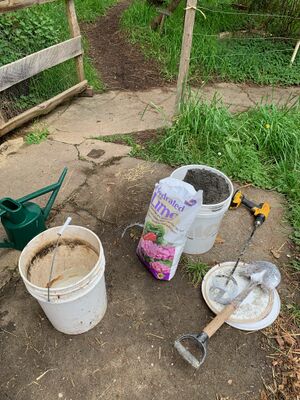

The lime-plastered hempcrete wall at CCAT is part of the reclamation station made to store materials for community members to use. It was designed and built in the spring of 2024 to protect the hempcrete from weather/water damage as well as to protect it from wear and tear from regular use.
Background[edit | edit source]
In a previous Engineering 305 class here at Humboldt, a team built a station to store and share materials with the community at CCAT. This shed has an exposed hempcrete wall that requires a natural finish to protect it from weathering. Hempcrete was an innovative way to produce building materials that were chemical-free and abundant in Humboldt. This new technique was even in the newspapers. Our team Aubrey, Jillian, Erik, and Jazz is composed of three studying mechanical engineering and one studying environmental engineering. We have various backgrounds in home and school projects in building with materials. Our client CCAT, Campus Center for Appropriate Technology focuses on sustainable living and education. This organization is student-led and funded providing resources, workshops, and classes to the Humboldt community. CCAT’s mission is “CCAT strives to demonstrate that living lightly on the Earth is both practical and rewarding.”
Problem statement[edit | edit source]
The objective of this project is to find an effective sealant for the hempcrete wall, that will need to be made of appropriate technology. This wall will also contain a peek-a-boo window feature showcasing hempcrete. Additionally, providing educational signage on process of creation and beautification. We plan on covering and sealing the hempcrete wall with lime plaster to protect it from wear and tear. The goal of this lime plaster is to preserve the hempcrete wall for a long time, allowing CCAT to store materials in the hempcrete station for student use.
Criteria[edit | edit source]
Include a brief intro to the criteria and then include a table with constraints and weights (0-10 highest).
| Criteria | Constraints | Weight (1-10) |
|---|---|---|
| Durability | Must last a minimum of 5 years with varying elements and be strong enough to withstand community use. | 10 |
| Sustainable | Use materials that are reclaimed or have a minimal carbon emission output. | 9 |
| Aesthetics | Matches the artistic aesthetic of the nearby structures with natural pigments. | 8 |
| Educational | A clear easily understandable educational sign that anyone can come up to and understand with anyone else present. | 7 |
| Maintenance | Minimal maintenance with maybe patch-up work every 5 years | 6 |
| Cost | Less than $450. The team has $2000 available left over from the original grant for the Hempcrete wall. | 4 |
Prototyping[edit | edit source]
The first design for prototyping was a few different types of plasters with different ratios. The first set of lime plaster prototyping was a 1:2.5, and a 1.5:2.5 lime to sand plaster. With half of the lime plaster prototypes we mixed the hydrated lime with water before mixing with the sand and then with the other half we mixed the lime and sand dry then added water. We found that if we mix the lime with water first it has a better result of limiting hydrated lime powder clumps. So we included this technique in our final plaster. We also tested clay plaster as an alternative. The ratio for the clay was 1:3 clay to sand. Are prototypes broken up into base and top layers. The base has some sort of fiber to improve strength and crack resistance and the top layer with none but more lime for water resistance. Additionally tested adding oxblood for waterproof and water resistance. This prototype didn't work out because the blood congealed and did not combine well with the lime and oxidized when drying.
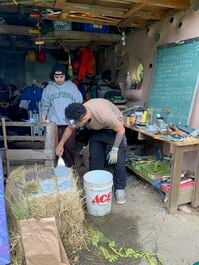
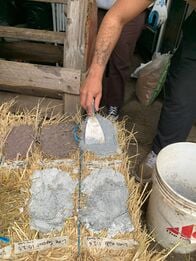
Final product[edit | edit source]
Final product that was a 3 layer hemp lime plaster in a 1.5:2.5 ratio of hydrated lime to sand as well as hemp hurds in the base layer. The hemp hurds in the base layer were to strengthen the plaster, which was beneficial for the layer right up against the wall. The second layer of plaster is in a 1.5:2.5 ratio of hydrated lime to sand which was found to be the best balance between the strongest and most water resistant of the tested plasters. The final layer of plaster is a 1.5:2.5 ratio of hydrated lime to sand with pigments added until the desired color is reached. The design also features a truth window made of plexiglass exposing the layers of hempcrete and the wooden two-by-fours holding the wall together. Finally, the wall includes a sign explaining the uses and building process of the reclamation station and hempcrete wall.
Construction[edit | edit source]
Construction process consisted getting empty buckets and adding 1.5:2.5 ratio of hydrated lime to sand then dry mix for five minutes. Once dry mixed add water to get to desired consistency while mixing for another five minutes, once finished the plaster can be applied to the wall. Further pigments and bases can be added for color and durability.
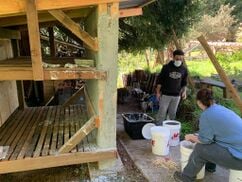
Video instructions[edit | edit source]
A good way to display a process is by making a video explaining your process. See Template:Video for information on how to add and annotate videos.
Bill of materials[edit | edit source]
Costs for materials used in the design and construction of the hempcrete wall lime plaster.
| Item | Amount | Cost per unit | Total |
|---|---|---|---|
| Hydrated Lime | 1 | USD 32.21 | USD 32.21 |
| Sand | 1 | USD 28.41 | USD 28.41 |
| Hooks | 1 | USD 13.63 | USD 13.63 |
| Mounts/Utility Box | 1 | USD 17.76 | USD 17.76 |
| Buckets | 1 | USD 32.88 | USD 32.88 |
| Tape | 1 | USD 16.37 | USD 16.37 |
| Clay | 1 | USD 13.99 | USD 13.99 |
| Pigments | 1 | USD 52.75 | USD 52.75 |
| Grand total | USD 208EUR 178.88 <br />GBP 151.84 <br />CAD 257.92 <br />MXN 4,336.80 <br />INR 15,568.80 <br /> | ||
Maintenance[edit | edit source]
The lime plaster does not require high maintenance, only maintenance includes the need to wipe the plastered wall with a dry rag occasionally due to climate conditions. As well as patch-up work every ten years. This should be performed by CCAT staff.
Maintenance schedule[edit | edit source]
The only maintenance required for CCAT would be the following:
- Monthly
- wipe down moisture
- Every 10 years
- plaster patch work
Conclusion[edit | edit source]
Testing results[edit | edit source]
Testing results with the 2.5:1.5 ratio of sand to lime worked best with the scrape test and water test and with overall workability when plastering.
| Plaster | Scrape Test (dry) | Scrape Test (wet) | Cracking? | notes |
| Old team's (sheep wool) | - | - | - | didn't dry |
| 2:1 sand:lime | 9 | 8 | no | strong |
| 2.5:1.5 sand:lime | 10 | 10 | no | strong |
| 2.5:1 sand:lime | 9 | 8 | no | flaky |
| 2:1 sand:lime w/ hemp fibers | 9 | 8 | no | pretty strong, not sticky |
| 2.5:1.5 sand:lime w/ hemp fibers | 10 | 10 | no | strong |
| clay | 7 | 0 | yes | soaked up water |
| 1:1 sand:lime | 5 | 5 | yes | cracked a lot |
| 10 best | 1 worst |
Discussion[edit | edit source]
The main criteria for the tested plasters were how well they passed the scrape test, both wet and dry, as well as if they cracked when dry and if they were sticky enough to apply to the wall when wet. Testing results revealed that the 2.5:1.5 ratio of sand to lime was both the strongest and most water-resistant plaster, as well as the easiest to spread without cracking. The plaster from the original reclamation station team did not dry, even after sitting out for a month. The plaster still appears soft and damp, and the sand used in it was too fine. The 2:1 ratio of sand to lime with hemp and without was decently strong and held up to water, but wasn’t sticky enough and was difficult to spread on the wall. Both of the clay plasters cracked after being dried and soaked up water when exposed to it. The 2.5:1.5 ratio of sand to lime, both with and without hemp, proved to be the best as it was sticky enough to stick to the wall while still having enough sand to prevent cracking in the plaster. While testing the pigments, it was evident that adding pigments until the plaster looked like the desired color was the best and most efficient method.
Lessons learned[edit | edit source]
Discuss lessons were learned during this project and what you would do different next time.
Next steps[edit | edit source]
The nest step for the Resource Reclamation Station is getting the word out. This is because many students at Cal Poly Humboldt have no clue the Resource Reclamation Station exist as a resource for them. There is no next step for the plaster.
Troubleshooting[edit | edit source]
If your are having trouble with your hemp lime plaster follow the table below and look for your problem then our suggested solution.
| Problem | Suggestion |
|---|---|
| Plaster not sticking to wall | Add need more hydrated lime or apply with more pressure |
| Plaster is cracking | Add more sand or hemp hurds |
| Plaster isn't smooth | Add more water or apply with more pressure |
| Plaster wont dry | Add more air flow or less water in mix |
| Plaster is clumpy | Mix hydrated lime throughly with water then add sand |
Team[edit | edit source]
Introduce team and semester in the following format:
- Lonny Grafman
- Emilio Velis
- Jillian Abes
- Aubrey Ostermann
- Jazz Quincy
- Erik Trimmer
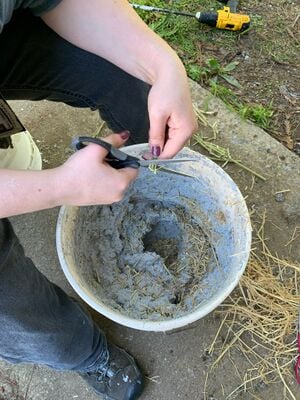
References[edit | edit source]
AB Drylining. (2023, November 16). Earthen Plaster: An all-you-Need-To-Know guide.
https://abdrylining.com/earthen-plaster/
Abbott, T. (2023, March 13). Hempcrete factsheet. The Limecrete Company.
https://limecrete.co.uk/hempcrete-factsheet/
Aceto, M. (2021, October). Pigments—the palette of organic colourants in wall
paintings. Research Gate.
https://www.researchgate.net/publication/354459410_Pigments-the_palette_of
organic_colourants_in_wall_paintings
Ashour, T., Bahnasawy, A., & Ali, S. (2010). Absorption and desorption behavior of
some clay–sandy plasters reinforced with natural fibers used for straw bale
buildings. Journal of Building Appraisal, 6(7), 171-181.
https://doi.org/10.1057/jba.2010.21
BigRentz. (2023, May 30). 20 Sustainable Building Materials for a Greener Future.
Bigrentz. https://www.bigrentz.com/blog/sustainable-construction
Buchholz, E. L., Bühler, G., Hille, K., Kaeppele, S., & Stotland, I. (2007). Art: A World
History. Abrams.
Cal Poly Humboldt. (n.d.). Home. Campus Center for Appropriate Technology (CCAT). https://ccat.humboldt.edu/#:~:text=
Conserv. (n.d.). The lime Plaster guide. Conserv®.
https://www.lime-mortars.co.uk/lime-plaster/guides/the-lime-plaster-guide
Dorsey, B. (2022). Building a foundation of pragmatic architectural theory to support
more sustainable or regenerative straw bale building and code adoption. Journal
of Sustainability Research. https://doi.org/10.20900/jsr20220003
Eckel, E. C. (1928). Cements, limes, and plasters: Their materials, manufacture and
properties.
Gatley, N. (2023, January 26). What is sustainable construction and why is it important? British Assessment Bureau.
https://www.british-assessment.co.uk/insights/what-is-sustainable-construction-
Glé, P., Gourdon, E., & Arnaud, L. (2013). Acoustical properties of hemp concretes.
Bio‐aggregate‐based Building Materials, 243-266.
https://doi.org/10.1002/9781118576809.ch7
HempSaveEarth. (2022, July 22). Sound absorption of a Hempcrete wall and hemp
acoustic panel. Medium.
https://medium.com/@hempsaveearth/sound-absorption-of-a-hempcrete-wall-a
d-hemp-acoustic-panel-b0ae4915e40f
Krishankumar, R., Mishra, A. R., Cavallaro, F., Zavadskas, E. K., Antuchevičienė, J., &
Ravichandran, K. S. (2022). A new approach to the viable ranking of
zero-carbon construction materials with generalized fuzzy information.
Sustainability, 14(13), 7691. https://doi.org/10.3390/su14137691
Morag. (2019, June 23). Making egg tempera paint with dry pigments. Celtic
Sustainables.
https://www.celticsustainables.co.uk/blog/making-egg-tempera-paint-with-dry-pi
NBAlliance. (2022, December 6).
https://natural-building-alliance.org/natural-plaster/
O'Hanlon, G. (2013, June 3). Safe handling of pigments. Artist Supplies | Natural
Pigments | Rublev Colours Artist Supplies.
https://www.naturalpigments.com/artist-materials/pigment-health-safety
Rasmus. (n.d.). Hempcrete. Appropedia, the sustainability wiki.
https://www.appropedia.org/Hempcrete
SCHUMACHER, E. F. (1973). SMALL IS BEAUTIFUL, Economics as If People
Mattered. daastol.com - welcome and sitemap.
https://www.daastol.com/books/Schumacher%20(1973)%20Small%20is%20Be utiful.pdf
Serotta, A., Seibert, J. M., & Stünkel, I. (2020, July 20). Paint like an Egyptian! The Metropolitan Museum of Art.
https://www.metmuseum.org/blogs/metkids/2020/paint-like-an-egyptian
United Nations. (n.d.). Sustainability.
https://www.un.org/en/academic-impact/sustainability
Yadav, M., & Saini, A. (2022, August 16). Opportunities & challenges of hempcrete as a
building material for construction: An overview. sciencedirect.com.
https://www.sciencedirect.com/science/article/pii/S2214785322039062
Zavadskas, E. K., Šaparauskas, J., & Antuchevičienė, J. (2018). Sustainability in
construction engineering. MDPI.
